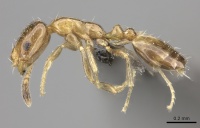Monomorium symmotu
| Monomorium symmotu | |
|---|---|

| |
| Scientific classification | |
| Kingdom: | Animalia |
| Phylum: | Arthropoda |
| Class: | Insecta |
| Order: | Hymenoptera |
| Family: | Formicidae |
| Subfamily: | Myrmicinae |
| Tribe: | Solenopsidini |
| Genus: | Monomorium |
| Species: | M. symmotu |
| Binomial name | |
| Monomorium symmotu Bolton, 1987 | |
The only known non-type collection of this species was obtained in a grassland.
Identification
Bolton (1987) - A member of the M. rhopalocerum complex in the M. monomorium species group. A small member of the rhopalocerum-complex, symmotu most closely resembles Monomorium exchao (=Monomorium termitobium). The two are separated by their differently shaped alitrunk and petiole outlines and by the presence in symmotu of only 3 pairs of standing hairs on the promesonotal dorsum. Further notes are given under Monomorium rhopalocerum.
Keys including this Species
Distribution
Latitudinal Distribution Pattern
Latitudinal Range: -3.88333° to -28.66667°.
| North Temperate |
North Subtropical |
Tropical | South Subtropical |
South Temperate |
- Source: AntMaps
Distribution based on Regional Taxon Lists
Afrotropical Region: Zimbabwe (type locality), Zimbabwe (type locality), Zimbabwe (type locality), Zimbabwe (type locality).
Distribution based on AntMaps
Distribution based on AntWeb specimens
Check data from AntWeb
Countries Occupied
| Number of countries occupied by this species based on AntWiki Regional Taxon Lists. In general, fewer countries occupied indicates a narrower range, while more countries indicates a more widespread species. |

|
Estimated Abundance
| Relative abundance based on number of AntMaps records per species (this species within the purple bar). Fewer records (to the left) indicates a less abundant/encountered species while more records (to the right) indicates more abundant/encountered species. |

|
Biology
Castes
Images from AntWeb
   
| |
| Paratype of Monomorium symmotu. Worker. Specimen code casent0902237. Photographer Will Ericson, uploaded by California Academy of Sciences. | Owned by NHMUK, London, UK. |
Nomenclature
The following information is derived from Barry Bolton's Online Catalogue of the Ants of the World.
- symmotu. Monomorium symmotu Bolton, 1987: 414, fig. 79 (w.) ZIMBABWE.
- Type-material: holotype worker, 19 paratype workers.
- Type-locality: Zimbabwe (“Rhodesia”): Vumba Mts, nr Umtali, 11.iii.1969 (W.L. Brown); paratypes with same data.
- Type-depositories: MCZC (holotype); BMNH, MCZC (paratypes).
- Status as species: Bolton, 1995b: 267.
- Distribution: Zimbabwe.
Unless otherwise noted the text for the remainder of this section is reported from the publication that includes the original description.
Description
Worker
Holotype. TL 1.9, HL 0.52, HW 0.39, CI 75, SL 0.35, SI 90, PW 0.25, AL 0.56.
Clypeal carinae distinct, close together and only weakly divergent anteriorly. Space between the clypeal carinae almost transversely fiat, only extremely feebly concave. Anterior clypeal margin between apices of the carinae extremely feebly concave, almost transverse. Anterior margin of prominent median portion of clypeus rounding bluntly into lateral margins, the two not separated by sharp angles or projecting denticles. Maximum diameter of eye 0.21 x HW and with 6 ommatidia in the longest row. In full-face view the posterior margins of the eyes conspicuously in front of the midlength of the sides. Antennal scapes, when laid straight back from their insertions, failing to reach the occipital margin. Sides of head behind eyes shallowly convex and feebly convergent posteriorly, the occipital margin distinctly concave medially. Promesonotum in profile evenly convex and on a higher level than the propodeum. Posteriormost portion of mesonotum suddenly downcurved and descending steeply to the broad and deeply impressed metanotal groove. Metanotal cross-ribs strong and conspicuous; propodeal spiracle small. Propodeal dorsum in profile evenly convex, highest behind metanotal groove ; the dorsum and declivity rounding broadly and evenly together so that they form a single convex curve. Node of petiole low and broad in profile, broadly rounded above; in dorsal view the node subglobular. Antero-ventral process of petiole peduncle a narrow cuticular strip. Postpetiole in profile smaller than petiole, lower and much more broadly rounded dorsally. All dorsal surfaces of head and body with standing hairs but these are relatively sparse; only 3 pairs present on the promesonotum. Sculpture absent except for scattered hair-pits and metanotal cross-ribs; the mesopleuron with some faint sculptural vestiges at about its midlength. Colour yellow.
Paratypes. TL 1.8-1.9, HL 0.48-0.52, HW 0.36-0.39, CI 74-76, SL 0.34-0.35, SI 89-94, PW 0.23-0.25, AL 0.52-0.56 (8 measured). Maximum diameter of eye 0.20-0.23 x HW and with 5-6 ommatidia in the longest row. Otherwise as holotype.
Type Material
Holotype worker, Zimbabwe (Rhodesia on label): Vumba Mts, or Umtali, 11.iii.1969 (W. L. Brown) (Museum of Comparative Zoology). Paratypes, 19 workers with same data as holotype (MCZ; The Natural History Museum).
References
- Bolton, B. 1987. A review of the Solenopsis genus-group and revision of Afrotropical Monomorium Mayr (Hymenoptera: Formicidae). Bulletin of the British Museum (Natural History). Entomology. 54:263-452.. (page 414, fig. 79 worker described)
References based on Global Ant Biodiversity Informatics
- IZIKO South Africa Museum Collection

